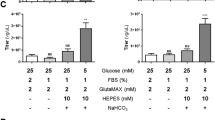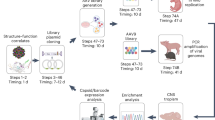Abstract
Adenovirus (Ad)-based vectors are useful gene delivery vehicles for a variety of applications. Despite their attractive properties, many in vivo applications require modulation of the viral tropism. Targeting approaches applied to adenoviral vectors included genetic modification of the viral capsid, controlled expression of the transgene and combinatorial approaches that combine two or more targeting elements in single vectors. Most of these studies confirmed successful retargeting in cell cultures, however, in vivo gains of targeted adenoviral vectors have not been widely demonstrated. We have developed a combinatorial retargeting approach utilizing metabolically biotinylated Ad, where the biotin acceptor peptide was incorporated in one of the fibers in a dual fiber viral particle resulting in metabolically biotinylated fiber-mosaic Ad (mBfMAd). We have utilized this vector in complex with epidermal growth factor (EGF)-Streptavidin to retarget fiber-mosaic virus to EGF receptor (EGFR) expressing cells in vitro and confirmed an increased infectivity of the retargeting complex. Most importantly, the utility of this strategy was demonstrated in vivo in two distinct animal models. In both models tested, retargeted mBfMAd demonstrated an increased ratio of gene expression in target tissues compared to the liver expression profile. Thus, metabolically biotinylated fiber-mosaic virus in combination with appropriate adapters can be successfully exploited for adenoviral retargeting strategies.
This is a preview of subscription content, access via your institution
Access options
Subscribe to this journal
Receive 12 print issues and online access
$259.00 per year
only $21.58 per issue
Buy this article
- Purchase on Springer Link
- Instant access to full article PDF
Prices may be subject to local taxes which are calculated during checkout





Similar content being viewed by others
References
Reynolds PN, Zinn KR, Gavrilyuk VD, Balyasnikova IV, Rogers BE, Buchsbaum DJ et al. A targetable, injectable adenoviral vector for selective gene delivery to pulmonary endothelium in vivo. Mol Ther 2000; 2: 562–578.
Everts M, Kim-Park SA, Preuss MA, Passineau MJ, Glasgow JN, Pereboev AV et al. Selective induction of tumor-associated antigens in murine pulmonary vasculature using double-targeted adenoviral vectors. Gene Therapy 2005; 12: 1042–1048.
Nettelbeck DM, Miller DW, Jerome V, Zuzarte M, Watkins SJ, Hawkins RE et al. Targeting of adenovirus to endothelial cells by a bispecific single-chain diabody directed against the adenovirus fiber knob domain and human endoglin (CD105). Mol Ther 2001; 3: 882–891.
Campos SK, Parrott MB, Barry MA . Avidin-based targeting and purification of a protein IX-modified, metabolically biotinylated adenoviral vector. Mol Ther 2004; 9: 942–954.
Campos SK, Barry MA . Comparison of adenovirus fiber, protein IX, and hexon capsomeres as scaffolds for vector purification and cell targeting. Virology 2006; 349: 453–462.
Pereboeva L, Komarova S, Mahasreshti PJ, Curiel DT . Fiber-mosaic adenovirus as a novel approach to design genetically modified adenoviral vectors. Virus Res 2004; 105: 35–46.
Cronan Jr JE . Biotination of proteins in vivo. A post-translational modification to label, purify, and study proteins. J Biol Chem 1990; 265: 10327–10333.
Parrott MB, Barry MA . Metabolic biotinylation of recombinant proteins in mammalian cells and in mice. Mol Ther 2000; 1: 96–104.
Sano T, Pandori MW, Chen X, Smith CL, Cantor CR . Recombinant core streptavidins. A minimum-sized core streptavidin has enhanced structural stability and higher accessibility to biotinylated macromolecules. J Biol Chem 1995; 270: 28204–28209.
Ponnazhagan S, Mahendra G, Kumar S, Thompson JA, Castillas Jr M . Conjugate-based targeting of recombinant adeno-associated virus type 2 vectors by using avidin-linked ligands. J Virol 2002; 76: 12900–12907.
Chen P, Murphy-Ullrich JE, Wells A . A role for gelsolin in actuating epidermal growth factor receptor-mediated cell motility. J Cell Biol 1996; 134: 689–698.
Dmitriev I, Kashentseva E, Rogers BE, Krasnykh V, Curiel DT . Ectodomain of coxsackievirus and adenovirus receptor genetically fused to epidermal growth factor mediates adenovirus targeting to epidermal growth factor receptor-positive cells. J Virol 2000; 74: 6875–6884.
Tallone T, Malin S, Samuelsson A, Wilbertz J, Miyahara M, Okamoto K et al. A mouse model for adenovirus gene delivery. Proc Natl Acad Sci USA 2001; 98: 7910–7915.
Gu DL, Gonzalez AM, Printz MA, Doukas J, Ying W, D'Andrea M et al. Fibroblast growth factor 2 retargeted adenovirus has redirected cellular tropism: evidence for reduced toxicity and enhanced antitumor activity in mice. Cancer Res 1999; 59: 2608–2614.
Fisher KD, Stallwood Y, Green NK, Ulbrich K, Mautner V, Seymour LW . Polymer-coated adenovirus permits efficient retargeting and evades neutralising antibodies. Gene Therapy 2001; 8: 341–348.
Lanciotti J, Song A, Doukas J, Sosnowski B, Pierce G, Gregory R et al. Targeting adenoviral vectors using heterofunctional polyethylene glycol FGF2 conjugates. Mol Ther 2003; 8: 99–107.
Roelvink PW, Mi Lee G, Einfeld DA, Kovesdi I, Wickham TJ . Identification of a conserved receptor-binding site on the fiber proteins of CAR-recognizing adenoviridae. Science 1999; 286: 1568–1571.
Dmitriev I, Krasnykh V, Miller CR, Wang M, Kashentseva E, Mikheeva G et al. An adenovirus vector with genetically modified fibers demonstrates expanded tropism via utilization of a coxsackievirus and adenovirus receptor-independent cell entry mechanism. J Virol 1998; 72: 9706–9713.
Wickham TJ, Tzeng E, Shears II LL, Roelvink PW, Li Y, Lee GM et al. Increased in vitro and in vivo gene transfer by adenovirus vectors containing chimeric fiber proteins. J Virol 1997; 71: 8221–8229.
van Beusechem VW, van Rijswijk AL, van Es HH, Haisma HJ, Pinedo HM, Gerritsen WR . Recombinant adenovirus vectors with knobless fibers for targeted gene transfer. Gene Therapy 2000; 7: 1940–1946.
Magnusson MK, Hong SS, Boulanger P, Lindholm L . Genetic retargeting of adenovirus: novel strategy employing ‘deknobbing’ of the fiber. J Virol 2001; 75: 7280–7289.
Mercier GT, Campbell JA, Chappell JD, Stehle T, Dermody TS, Barry MA . A chimeric adenovirus vector encoding reovirus attachment protein sigma1 targets cells expressing junctional adhesion molecule 1. Proc Natl Acad Sci USA 2004; 101: 6188–6193.
Krasnykh V, Belousova N, Korokhov N, Mikheeva G, Curiel DT . Genetic targeting of an adenovirus vector via replacement of the fiber protein with the phage T4 fibritin. J Virol 2001; 75: 4176–4183.
Belousova N, Korokhov N, Krendelshchikova V, Simonenko V, Mikheeva G, Triozzi PL et al. Genetically targeted adenovirus vector directed to CD40-expressing cells. J Virol 2003; 77: 11367–11377.
Parrott MB, Adams KE, Mercier GT, Mok H, Campos SK, Barry MA . Metabolically biotinylated adenovirus for cell targeting, ligand screening, and vector purification. Mol Ther 2003; 8: 688–700.
Haisma HJ, Grill J, Curiel DT, Hoogeland S, van Beusechem VW, Pinedo HM et al. Targeting of adenoviral vectors through a bispecific single-chain antibody. Cancer Gene Ther 2000; 7: 901–904.
Watkins SJ, Mesyanzhinov VV, Kurochkina LP, Hawkins RE . The ‘adenobody’ approach to viral targeting: specific and enhanced adenoviral gene delivery. Gene Therapy 1997; 4: 1004–1012.
Hemminki A, Dmitriev I, Liu B, Desmond RA, Alemany R, Curiel DT . Targeting oncolytic adenoviral agents to the epidermal growth factor pathway with a secretory fusion molecule. Cancer Res 2001; 61: 6377–6381.
van Beusechem VW, Grill J, Mastenbroek DC, Wickham TJ, Roelvink PW, Haisma HJ et al. Efficient and selective gene transfer into primary human brain tumors by using single-chain antibody-targeted adenoviral vectors with native tropism abolished. J Virol 2002; 76: 2753–2762.
Kolibaba KS, Druker BJ . Protein tyrosine kinases and cancer. Biochim Biophys Acta 1997; 1333: F217–F248.
Liang Q, Dmitriev I, Kashentseva E, Curiel DT, Herschman HR . Noninvasive of adenovirus tumor retargeting in living subjects by a soluble adenovirus receptor-epidermal growth factor (sCAR-EGF) fusion protein. Mol Imag Biol 2004; 6: 385–394.
Printz MA, Gonzalez AM, Cunningham M, Gu DL, Ong M, Pierce GF et al. Fibroblast growth factor 2-retargeted adenoviral vectors exhibit a modified biolocalization pattern and display reduced toxicity relative to native adenoviral vectors. Hum Gene Ther 2000; 11: 191–204.
Rancourt C, Rogers BE, Sosnowski BA, Wang M, Piche A, Pierce GF et al. Basic fibroblast growth factor enhancement of adenovirus-mediated delivery of the herpes simplex virus thymidine kinase gene results in augmented therapeutic benefit in a murine model of ovarian cancer. Clin Cancer Res 1998; 4: 2455–2461.
Tanaka T, Huang J, Hirai S, Kuroki M, Watanabe N, Tomihara K et al. Carcinoembryonic antigen-targeted selective gene therapy for gastric cancer through FZ33 fiber-modified adenovirus vectors. Clin Cancer Res 2006; 12: 3803–3813.
Izumi M, Kawakami Y, Glasgow JN, Belousova N, Everts M, Kim-Park S et al. In vivo analysis of a genetically modified adenoviral vector targeted to human CD40 using a novel transient transgenic model. J Gene Med 2005; 7: 1517–1525.
Bonner JA, Buchsbaum DJ, Russo SM, Fiveash JB, Trummell HQ, Curiel DT et al. Anti-EGFR-mediated radiosensitization as a result of augmented EGFR expression. Int J Radiat Oncol Biol Phys 2004; 59: 2–10.
Krasnykh V, Belousova N, Korokhov N, Mikheeva G, Curiel DT . Genetic targeting of an adenovirus vector via replacement of the fiber protein with the phage T4 fibritin. J Virol 2001; 75: 4176–4183.
Belousova N, Krendelchtchikova V, Curiel DT, Krasnykh V . Modulation of adenovirus vector tropism via incorporation of polypeptide ligands into the fiber protein. J Virol 2002; 76: 8621–8631.
Acknowledgements
We thank Joel Glasgow and Alex Pereboev for proofing the manuscript and helpful critique. This study was supported, in part, by NIH grants RO1CA083821-06, 1P01HL076540, 1P01CA104177-01A2, CA075930-07 and DOD grant W81XWH-05-1-0035 and Muscular Dystrophy Association.
Author information
Authors and Affiliations
Corresponding author
Rights and permissions
About this article
Cite this article
Pereboeva, L., Komarova, S., Roth, J. et al. Targeting EGFR with metabolically biotinylated fiber-mosaic adenovirus. Gene Ther 14, 627–637 (2007). https://doi.org/10.1038/sj.gt.3302916
Received:
Revised:
Accepted:
Published:
Issue Date:
DOI: https://doi.org/10.1038/sj.gt.3302916
Keywords
This article is cited by
-
Low-Affinity Neurotrophin Receptor p75 Promotes the Transduction of Targeted Lentiviral Vectors to Cholinergic Neurons of Rat Basal Forebrain
Neurotherapeutics (2016)
-
Streptavidin–biotin technology: improvements and innovations in chemical and biological applications
Applied Microbiology and Biotechnology (2013)
-
(Strept)avidin-displaying lentiviruses as versatile tools for targeting and dual imaging of gene delivery
Gene Therapy (2009)



